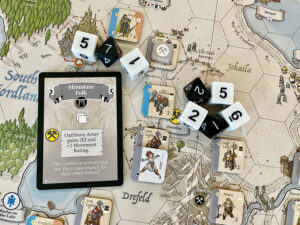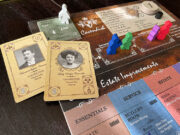 Enter the world of Kalar, filled to the brim with lore, vaunted heroes, fractured alliances, and the blessings of the gods. This land is littered with monsters of yore, ready to snap at any who come within range. The seasons turn as magic ebbs and flows. And that sound you hear on the horizon? It could be the coming of evil. The clash of blades. The whispers of the armies of the night. Or maybe even a siege engine nearing the gates.
Enter the world of Kalar, filled to the brim with lore, vaunted heroes, fractured alliances, and the blessings of the gods. This land is littered with monsters of yore, ready to snap at any who come within range. The seasons turn as magic ebbs and flows. And that sound you hear on the horizon? It could be the coming of evil. The clash of blades. The whispers of the armies of the night. Or maybe even a siege engine nearing the gates.
Burning Banners, published by Compass Games, is a wargame for two to six players. Six factions battle for control over a four-map landscape that has been beautifully illustrated by designer Christopher Moeller. It features eighteen unique scenarios as well as a ten-part chronicle to experience.
Gameplay Overview:
Burning Banners has two gameplay modes: Basic and Advanced. The Basic option allows players to learn the foundational ruleset, whereas the Advanced option layers new systems on top of this groundwork. There is no sandbox to play in but rather a campaign-driven style of play that contains bits of narrative flavor and setup specifics.
Each scenario features two sides: the Invader and the Resistance. Within each side, there may be multiple factions based on the number of players that the scenario indicates. Regardless of how many are playing, they can always decide to control more than one faction to attempt the scenario. Scenarios feature unique goals and pit the two sides against each other with a smirk.

As this is a wargame, it features units that are added to the hex-based map dependent on placement rules. These units move around to defend locations, capture new territory, and battle against their enemies. Each of the six factions features unique and thematic units with abilities such as ranged, stealth, and mage that provide new ways to approach battle.
Gameplay is turn-based where one side moves and takes actions with their units. Once all units have exhausted, play switches to the next faction in turn order. During a turn, players can spend their coins to build new units on the map at any time. If built in a controlled location with no other unit present, the unit can also move and take an action.
Everything is in service of the main objective. Sometimes this is controlling (or razing) several locations, sometimes this is lasting a certain number of seasons (rounds). Hexes feature different terrain types for movement with special rules that hinder or hasten unit steps. Due to the nature of the genre, many times the way to achieve these goals is through combat.
Combat is fast and furious. Each unit features a combat rating that indicates how many dice they roll. White indicates a six-sided die and black indicates an eight-sided die. Both attackers and defenders roll their unit’s pool of dice and compare results. A hit happens on a roll of five or greater unless other rules are in play. For each roll of seven or eight on a black die, the player can roll an additional white die for another chance at a hit. This is the Burning Banners crit system.

An example of combat follows: An attacking goblin warrior rolls two white dice and hits with both. The defending orc reaver rolls a black and a white die, hits with the black die only with a roll of seven, then rolls another white die due to the critical. Due to rolling two hits to the orc’s one, the goblin warrior damages the reaver once. Units have a maximum of two health, though some fragile units only have one.
There are plenty of rules overhead regarding certain specific instances of combat that happen around terrain, cities, and monsters. And the advanced mode adds both magic and blessing systems to spice things up. Magic is a common deck of cards that players can draw from, while blessings are faction-specific boons from their individual gods. These enhance combat and movement.
The advanced mode also adds heroes to the mix. Each faction has its own set of heroes that can stack with units. They provide their own unique ability, as well as the option to cast magic. They can also be squishy if not protected properly, but if defeated, they go right back into the player’s hero pool just like defeated units return to each faction’s mat.

Game Experience:
I was immediately drawn to Burning Banners based on its gorgeously illustrated maps. Each of the four region maps features detailed landscapes that provide an excellent sense of place. Some locations may just exist on the map until they show up as accessible in a later scenario. One hex features a unicorn frolicking in a field. There’s a lot of detail on display here.
The illustration extends to the hero and faction areas. Each hero and unit pops with character and adds a lot to faction buy-in. The Fjordland have a powerful drakken! The Orcs have massive dire ravens that can fly over your units. And each hero comes with a backstory and an ability that you can’t wait to employ.

The advanced mode additions do create more overhead to the game but not to its detriment. I’d only recommend the basic mode as a tutorial to learn the intricacies of the framework. Once the faction blessings and heroes show up the scenarios really shine as the battle takes on its own narrative and creates more footing for memorable moments.
The combat can be hit or miss, both literally and figuratively. I enjoy that it’s simple and fast. Sure, there are additional rules that can bog this down on occasion, but mostly you feel like you are hacking away at each other and building more units to join the fray along the way. Every combat is life or death as the dice find their way to push their luck-addled results right into your face. It’s fun, brutal, disheartening, and joyous. And it begs you to be strategic at the same time.
There are issues with Burning Banners. It has a bloated rulebook that tries too hard to cover every instance of the ruleset by spelling things out very slowly. It may be trying to appeal to a fresh audience, or perhaps it’s not confident with itself, but either way, it could use some trimming. There’s nuance around strikes and ambushes, control and income, movement and defense, as well as eight different states that a settlement can find itself in.

The addition of the magic system also bogs play down even though it can be fun to raise some dead or teleport units in the heat of battle. At the end of each turn, players are given an opportunity to refill their hand of magic and blessing cards. The magic system revolves around the seasons and there can be times when a churn appears and allows a faction to only choose between refreshing magic or blessings or treasure rather than all three. In trying to add more thematic flair, it creates an uneven moment in play.
The other issue is downtime. I can’t imagine playing this with more than three players. Maybe not even more than two. Waiting for an entire faction to take their turn or multiple faction turns if they control more than one, does not feel great. Players are invested as they must roll to defend, but it’s missing a back-and-forth flow that would make this shine even further. At least there is a phase structure that resets the focus after each player’s turn.

Final Thoughts:
I’m having a blast with Burning Banners. Yes, I do have to keep the rules nearby for reference. Yes, I want to house rule a few things here and there. And yes, there can be some unbalanced scenarios. That said, everything that comes in this box is in service to its world-building. Players take on the role of factions during specific moments in this land’s history. And it works. I’ve not even made it to the three-book (ten-part) campaign to see how the narrative flows along the way. But I will certainly find my way there. For the time being, I’m internalizing rules, making mistakes, and finding fun new details on these maps. Did I tell you about the beautiful maps? Hell, I may even forego this next objective just to go fight some monsters in their lair. Who knows what kind of treasure I’ll unearth next?
Final Score: 4 stars – A love letter to an earlier age of wargaming with a modern sheen.
 Hits:
Hits:
• Beautifully illustrated map and characters
• Six unique factions
• Simplified combat
• Thematic campaign designs
Misses:
• Crowded rulebook
• Player downtime
• Magic system
• Certain fiddly rules





















